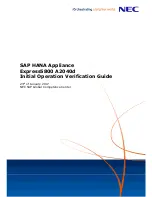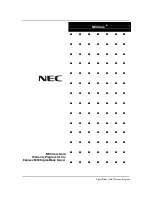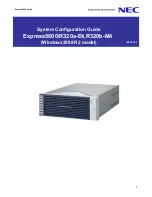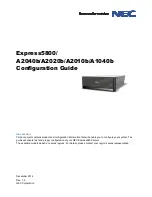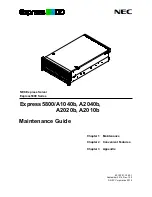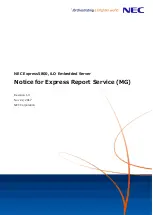
3-4 Setting Up Your Server
Do not install the rack in the places listed below. Installing the rack or mounting the server on the
rack in such a place may cause some malfunction to occur.
Narrow space from which devices cannot be pulled out from the rack completely
Place that cannot bear the total weights of the rack and devices mounted on the rack
Place where stabilizers cannot be installed or where the rack can be installed only after the
practice of proper earthquake-resistant construction
Place of uneven or slanting floor
Place of drastic temperature change (near a heater, air conditioner, or refrigerator)
Place where intense vibration may be generated
Place where corrosive gases (sulfur dioxide, hydrogen sulfide, nitrogen dioxide, chlorine,
ammonia, ozone, etc) exist.
Place where the air (or dust) includes components accelerating corrosion (ex. sulfur,
sodium chloride) or conductive metals.
Place where chemicals may be accidentally sprayed over
Place where a carpet not subject to anti-static process is laid.
Place where some objects may be fallen on the rack
Place near a device generating intense magnetic field (such as a TV, radio,
broadcast/communication antenna, power transmission wire, and electromagnetic crane) is
placed (If unavoidable, contact your service representative to request proper shield
construction.)
Place where the power cord of the server must be connected to an AC outlet that shares
the outlet of another device with large power consumption.
Place near equipment that generates power noise (e.g., contact spark at power-on/power-
off of commercial power supply through a relay). If you must install the server close to
such equipment, request your service representative for separate power cabling or noise
filter installation.
IMPORTANT:
Increase in temperature within rack and air flow
If more than one server are installed on the rack or the ventilation
within the rack is not enough, the temperature in the rack may be raised
by the heat generated from the units to be higher than the operation
temperature of the server (10 to 35°C).
It causes the server to operate improperly. Review the air flow within
the rack or in the room and take sufficient measures so that the
temperature within the rack does not exceed the warranted temperature
range during the system operation.
The server takes in the air from the front and exhausts it to the rear.
































